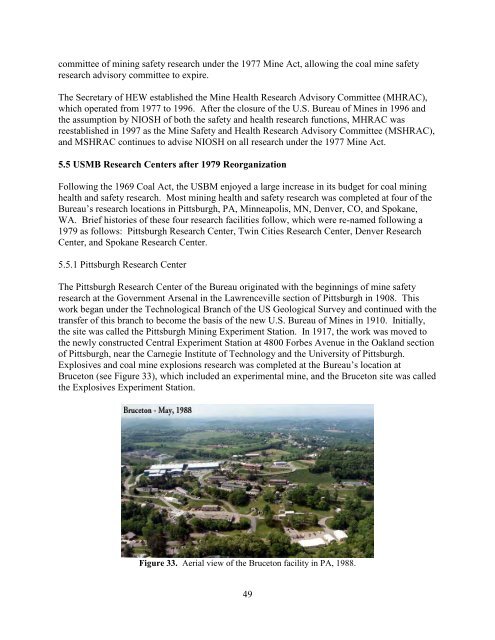One Hundred Years of Federal Mining Safety and Health Research
One Hundred Years of Federal Mining Safety and Health Research
One Hundred Years of Federal Mining Safety and Health Research
- No tags were found...
You also want an ePaper? Increase the reach of your titles
YUMPU automatically turns print PDFs into web optimized ePapers that Google loves.
committee <strong>of</strong> mining safety research under the 1977 Mine Act, allowing the coal mine safety<br />
research advisory committee to expire.<br />
The Secretary <strong>of</strong> HEW established the Mine <strong>Health</strong> <strong>Research</strong> Advisory Committee (MHRAC),<br />
which operated from 1977 to 1996. After the closure <strong>of</strong> the U.S. Bureau <strong>of</strong> Mines in 1996 <strong>and</strong><br />
the assumption by NIOSH <strong>of</strong> both the safety <strong>and</strong> health research functions, MHRAC was<br />
reestablished in 1997 as the Mine <strong>Safety</strong> <strong>and</strong> <strong>Health</strong> <strong>Research</strong> Advisory Committee (MSHRAC),<br />
<strong>and</strong> MSHRAC continues to advise NIOSH on all research under the 1977 Mine Act.<br />
5.5 USMB <strong>Research</strong> Centers after 1979 Reorganization<br />
Following the 1969 Coal Act, the USBM enjoyed a large increase in its budget for coal mining<br />
health <strong>and</strong> safety research. Most mining health <strong>and</strong> safety research was completed at four <strong>of</strong> the<br />
Bureau’s research locations in Pittsburgh, PA, Minneapolis, MN, Denver, CO, <strong>and</strong> Spokane,<br />
WA. Brief histories <strong>of</strong> these four research facilities follow, which were re-named following a<br />
1979 as follows: Pittsburgh <strong>Research</strong> Center, Twin Cities <strong>Research</strong> Center, Denver <strong>Research</strong><br />
Center, <strong>and</strong> Spokane <strong>Research</strong> Center.<br />
5.5.1 Pittsburgh <strong>Research</strong> Center<br />
The Pittsburgh <strong>Research</strong> Center <strong>of</strong> the Bureau originated with the beginnings <strong>of</strong> mine safety<br />
research at the Government Arsenal in the Lawrenceville section <strong>of</strong> Pittsburgh in 1908. This<br />
work began under the Technological Branch <strong>of</strong> the US Geological Survey <strong>and</strong> continued with the<br />
transfer <strong>of</strong> this branch to become the basis <strong>of</strong> the new U.S. Bureau <strong>of</strong> Mines in 1910. Initially,<br />
the site was called the Pittsburgh <strong>Mining</strong> Experiment Station. In 1917, the work was moved to<br />
the newly constructed Central Experiment Station at 4800 Forbes Avenue in the Oakl<strong>and</strong> section<br />
<strong>of</strong> Pittsburgh, near the Carnegie Institute <strong>of</strong> Technology <strong>and</strong> the University <strong>of</strong> Pittsburgh.<br />
Explosives <strong>and</strong> coal mine explosions research was completed at the Bureau’s location at<br />
Bruceton (see Figure 33), which included an experimental mine, <strong>and</strong> the Bruceton site was called<br />
the Explosives Experiment Station.<br />
Figure 33. Aerial view <strong>of</strong> the Bruceton facility in PA, 1988.<br />
49
















